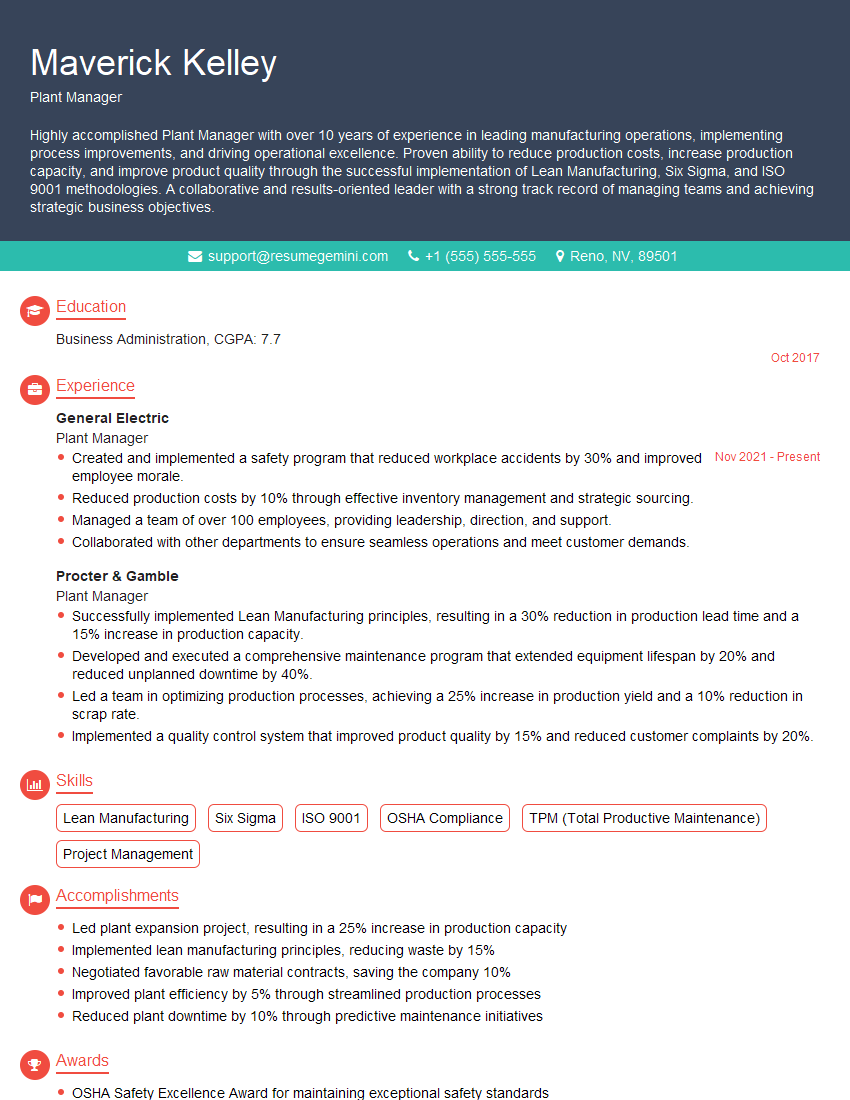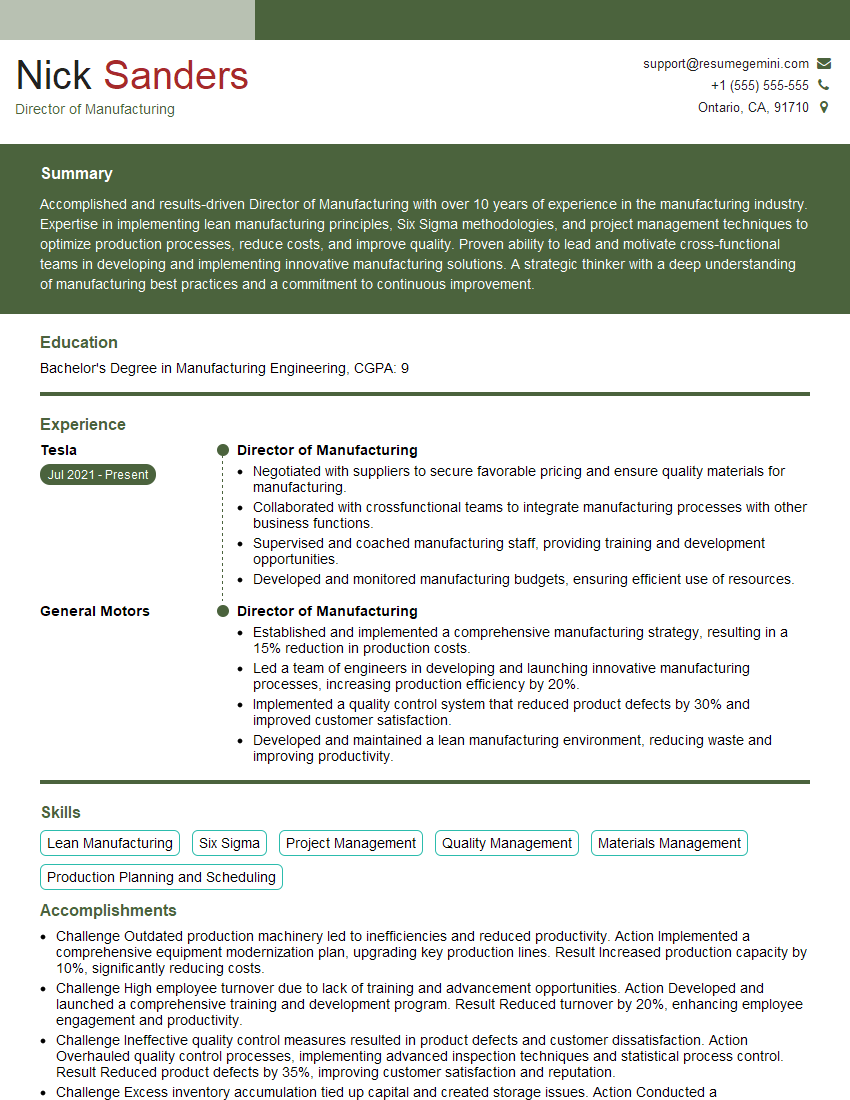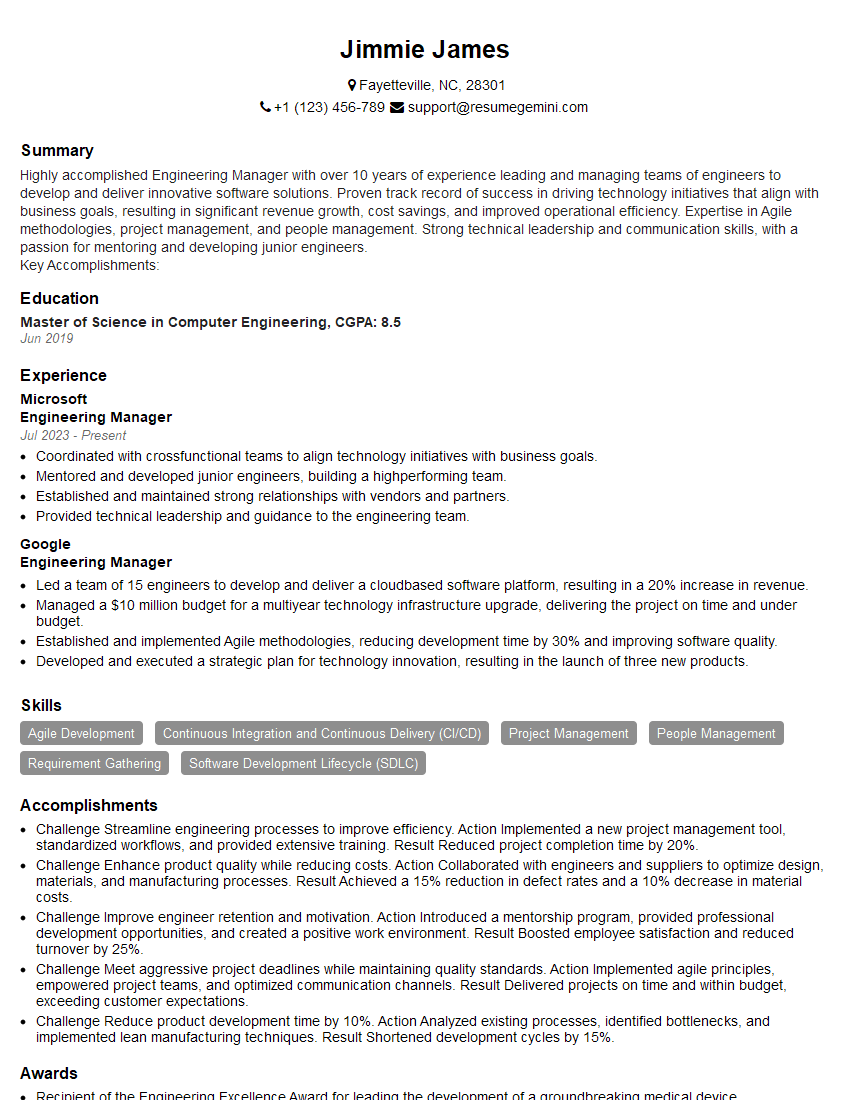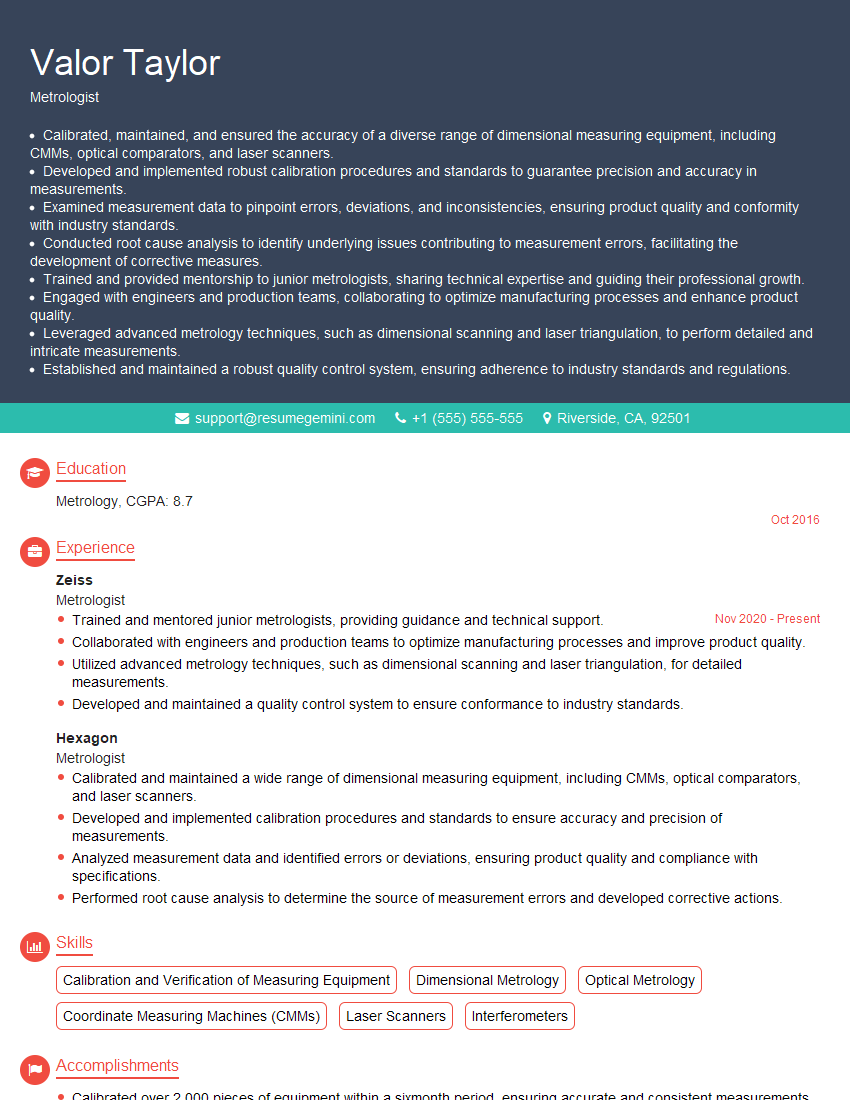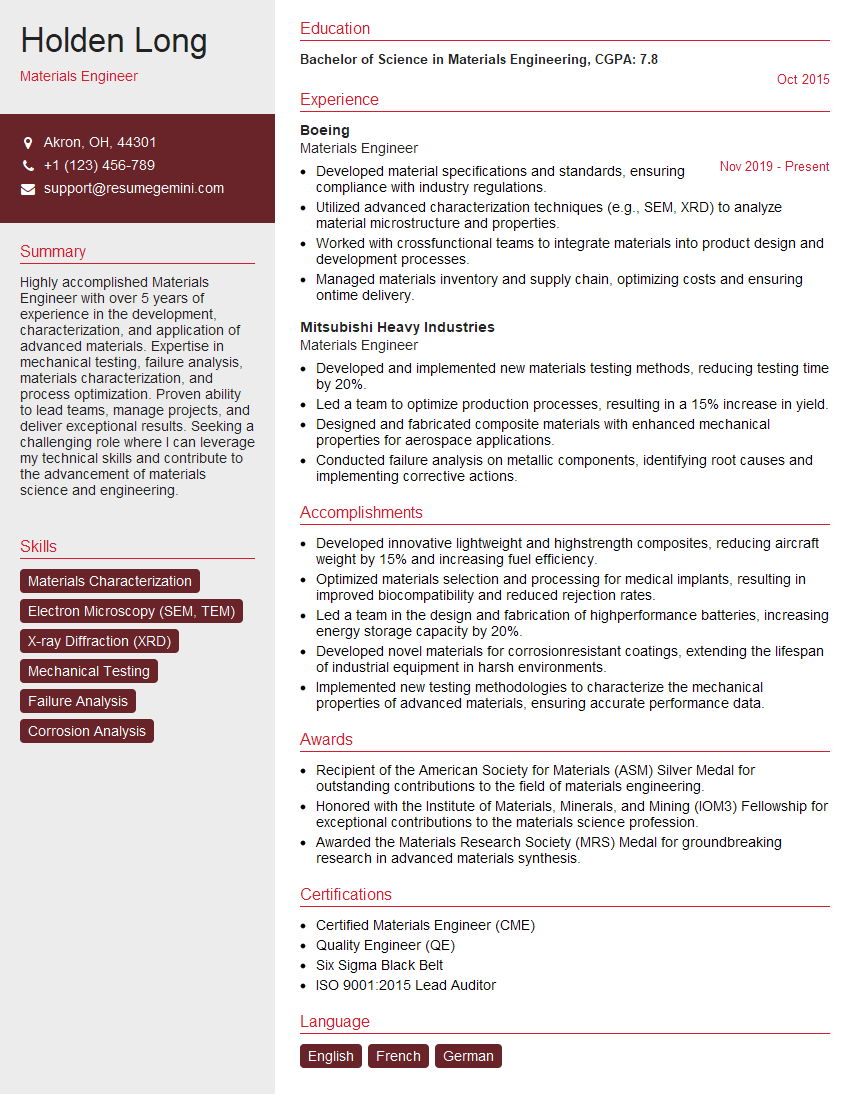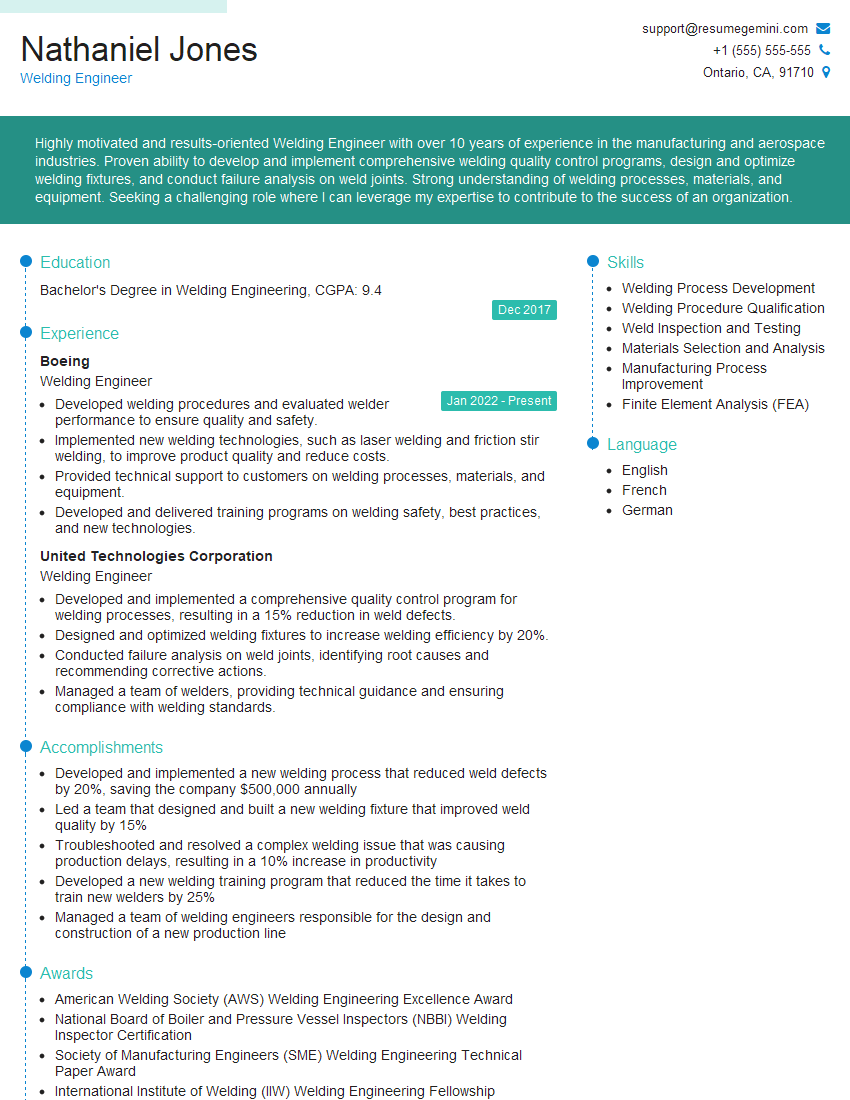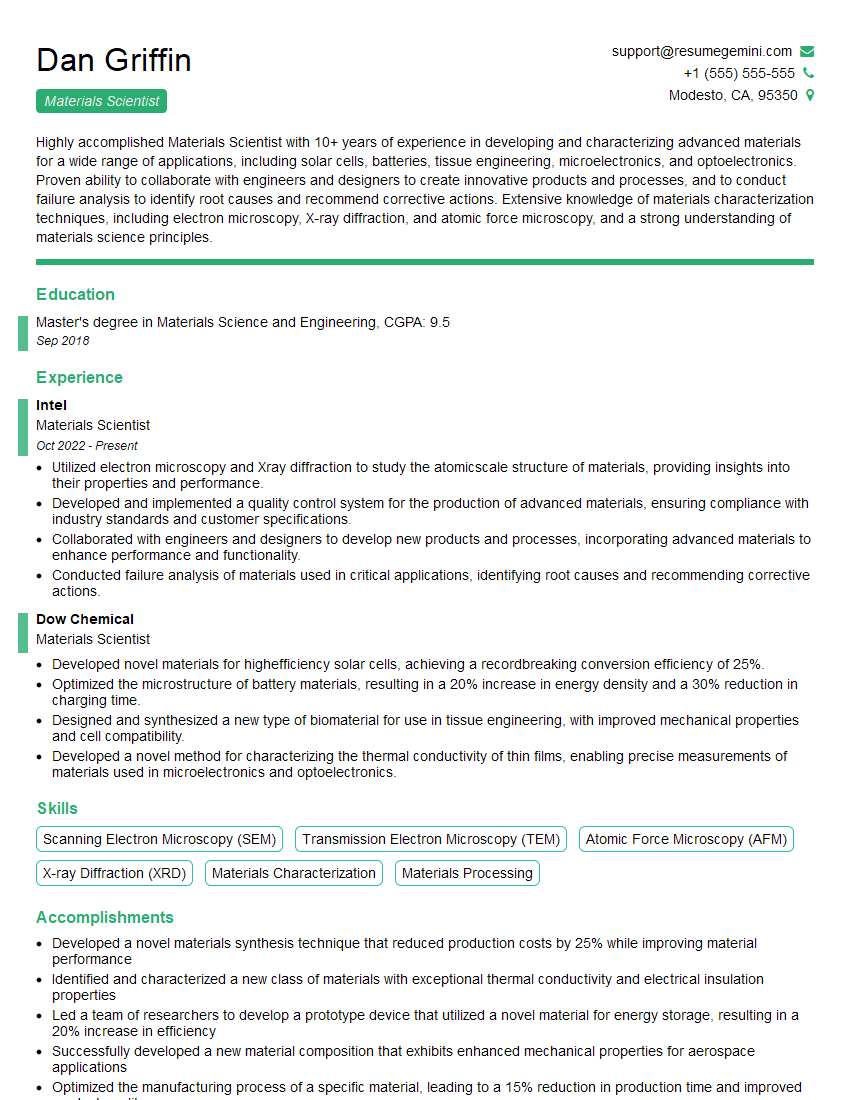The right preparation can turn an interview into an opportunity to showcase your expertise. This guide to Annealing and stress relieving interview questions is your ultimate resource, providing key insights and tips to help you ace your responses and stand out as a top candidate.
Questions Asked in Annealing and stress relieving Interview
Q 1. Explain the difference between annealing and stress relieving.
While both annealing and stress relieving involve heating and cooling a material to alter its properties, they differ in their primary goals. Annealing is a broader heat treatment process aimed at altering the microstructure of a material to improve its ductility, machinability, or other mechanical properties. Think of it like baking a cake – you’re changing its overall structure to make it softer and easier to handle. Stress relieving, on the other hand, focuses specifically on reducing internal stresses within a material caused by processes like welding, machining, or cold working. It’s like gently smoothing out wrinkles in a fabric after it’s been tightly folded.
In essence, stress relieving can be considered a type of annealing, but annealing encompasses a much wider range of heat treatments with various objectives.
Q 2. What are the different types of annealing processes?
Several types of annealing exist, each tailored to specific material and property requirements. These include:
- Full Annealing: This involves heating the material to a specific temperature above its critical transformation temperature, holding it there for a sufficient time, and then slowly cooling it in a furnace. This process softens the material, refines its grain size, and relieves internal stresses.
- Stress Relief Annealing: As discussed earlier, this focuses on reducing residual stresses, typically by heating the material to a temperature below its critical transformation temperature. It’s often used after welding or machining to prevent cracking or distortion.
- Process Annealing: Used for cold-worked metals, this anneal restores some ductility and improves machinability by heating the material to a temperature below its critical transformation temperature.
- Normalizing: This heat treatment involves heating the material above its upper critical temperature and then cooling it in still air. It results in a more uniform microstructure with improved mechanical properties compared to the as-cast or forged state.
- Spheroidizing Annealing: This process aims to change the shape of cementite (a hard constituent in steel) into round or spherical particles, improving machinability and ductility.
The choice of annealing type depends heavily on the material, its prior processing, and the desired final properties.
Q 3. Describe the purpose of stress relieving in manufacturing.
Stress relieving is crucial in manufacturing to mitigate the negative consequences of residual stresses. These stresses can be introduced during processes like welding, casting, machining, or even cold forming. High residual stresses can lead to several problems:
- Distortion: Parts may warp or bend after manufacturing due to uneven stress distribution.
- Brittle Fracture: Stresses can weaken the material, making it more susceptible to cracking under load.
- Reduced Fatigue Life: Residual stresses can significantly reduce the lifespan of components under cyclic loading.
- Dimensional Instability: The part may change dimensions over time due to stress relaxation.
Stress relieving minimizes these issues by reducing internal stresses, improving the overall dimensional stability, strength, and reliability of the manufactured components. Imagine a tightly wound spring – releasing some of that tension makes it less prone to snapping.
Q 4. How does grain size affect the properties of annealed material?
Grain size significantly impacts the properties of annealed material. Smaller grain sizes generally lead to:
- Increased Strength: Smaller grains offer more grain boundaries, which impede dislocation movement, leading to higher yield strength.
- Increased Hardness: Similar to increased strength, finer grains result in higher hardness.
- Improved Ductility (to a point): While excessive grain refinement can reduce ductility, a certain level of refinement can enhance it.
- Improved toughness: A combination of strength and ductility results in enhanced toughness.
However, excessively small grains can lead to decreased ductility and increased brittleness. Therefore, controlling grain size during annealing is critical for achieving optimal material properties. Think of it like building a wall – smaller bricks might make a stronger wall, but too many small bricks could also make it less flexible.
Q 5. What are the common methods for stress relieving?
Common methods for stress relieving include:
- Furnace Stress Relieving: The most common method, involving heating the component in a controlled environment to a specific temperature and holding it for a defined period before slow cooling.
- Local Stress Relieving: Used for localized stress areas, such as near welds. This can involve techniques like torch heating or induction heating.
- Vibration Stress Relieving: Applying high-frequency vibrations during cooling can help reduce stresses.
The selection of the best method depends on factors like the size and shape of the component, the material type, the level of stress to be reduced, and the available equipment. Often, a combination of methods might be employed for optimal results.
Q 6. Explain the concept of recrystallization in annealing.
Recrystallization is a crucial aspect of annealing, especially in cold-worked metals. Cold working introduces dislocations (crystal lattice imperfections) that increase the material’s strength and hardness but reduce its ductility. Recrystallization is the process where new, strain-free grains form and grow, consuming the distorted grains from the cold-worked structure. This happens at a specific temperature range and results in a softer, more ductile material with a refined grain structure. The temperature at which recrystallization begins is known as the recrystallization temperature.
Think of it like rearranging a messy room – the old, disordered structure (cold-worked metal) is replaced by a new, organized structure (recrystallized metal).
Q 7. How do you determine the optimal annealing temperature for a given material?
Determining the optimal annealing temperature for a given material requires careful consideration and often involves a combination of techniques:
- Material Properties: The material’s specific composition and phase transformations are crucial. Consulting phase diagrams and material datasheets is essential.
- Prior Processing: The amount of cold work, previous heat treatments, and any other processing steps can influence the optimal temperature.
- Desired Properties: The desired grain size, strength, ductility, and other properties dictate the appropriate annealing temperature and time.
- Experimental Determination: Small-scale experiments and thermal analysis (like Differential Scanning Calorimetry – DSC) can help determine the appropriate temperature range.
- Literature Review: Reviewing published research on the specific material and similar annealing processes can offer valuable insights.
A common approach involves performing a series of annealing trials at slightly varying temperatures and analyzing the resulting microstructure and mechanical properties. This iterative approach helps refine the optimal annealing parameters.
Q 8. What are the potential consequences of improper annealing?
Improper annealing can lead to a range of detrimental consequences, significantly impacting the final product’s quality and performance. Imagine baking a cake – if you don’t bake it long enough or at the right temperature, the result will be unsatisfactory. Similarly, incorrect annealing parameters result in a material that doesn’t meet the desired properties.
- Increased Brittleness: Incomplete annealing leaves residual stresses within the material, making it prone to cracking or fracturing under stress. This is particularly critical in applications requiring high strength and durability, such as aerospace components.
- Reduced Ductility: The material’s ability to deform before breaking is diminished, leading to premature failure. Think of a paperclip – a properly annealed paperclip can bend significantly before snapping; an improperly annealed one might break easily.
- Inconsistent Hardness: Variations in hardness across the material lead to uneven wear and tear, compromising its functionality. This is a concern in tools and machine parts that require consistent performance.
- Residual Stresses: These internal stresses can cause warping, distortion, or cracking over time, even under normal operating conditions. Imagine a metal plate bending slightly after annealing due to uneven cooling.
- Poor Machinability: The material might become difficult to machine or shape further, leading to increased production costs and time.
Q 9. How do you monitor and control the annealing process?
Monitoring and controlling the annealing process requires a combination of precise instrumentation and careful observation. It’s like carefully monitoring the temperature and time when baking – you need the right tools and attention to detail.
- Temperature Control: Precise temperature control is paramount, usually achieved using thermocouples or other sensors placed within the furnace or in contact with the material. Sophisticated control systems maintain the desired temperature throughout the process, adjusting heating elements as needed. Imagine a thermostat for your oven, but far more precise.
- Time Control: The annealing time is critical and is managed using timers integrated into the furnace control system. Accurate timing is crucial for achieving the desired microstructure and relieving stresses effectively.
- Atmosphere Control: For some materials, controlling the furnace atmosphere (e.g., inert gas like Argon) is crucial to prevent oxidation or other undesirable chemical reactions during heating. Imagine protecting a delicate cake from burning by baking it in a covered container.
- Data Logging: Modern annealing systems usually record temperature, time, and atmosphere data, providing a valuable record for process analysis and optimization. This data is useful for identifying and correcting deviations from the ideal annealing curve.
- Visual Inspection: Post-annealing visual inspection helps identify any macroscopic defects such as cracks, warping, or discoloration. This provides final quality assurance.
Q 10. Describe the role of time and temperature in annealing.
Time and temperature are inextricably linked in the annealing process; they act as the two crucial levers for achieving the desired material properties. Think of them as the recipe for our ‘material cake’.
- Temperature: The temperature determines the rate at which atoms diffuse and rearrange within the material. Higher temperatures accelerate atomic mobility, allowing for faster stress relief and microstructural changes.
- Time: Sufficient time is needed at the annealing temperature to allow for complete stress relief and the achievement of the desired microstructure. This ensures atoms have enough time to reorganize themselves into a more stable state. Insufficient time leads to incomplete annealing.
- Combined Effect: The interaction between time and temperature is crucial. A higher temperature allows for shorter annealing times, but excessively high temperatures can lead to undesirable grain growth or other negative effects. Conversely, a lower temperature might require significantly longer annealing times, potentially impacting production efficiency.
The optimal combination of time and temperature is material-specific and determined based on factors such as the material’s composition, its previous processing history, and the desired final properties.
Q 11. What are the common defects encountered during annealing?
Several defects can arise during annealing, usually stemming from inadequate control over the process parameters. Like a baker facing unexpected problems during cake baking, annealing can have its challenges.
- Oxidation: Reaction of the material with oxygen in the atmosphere, leading to surface scaling or embrittlement. This is common in high-temperature annealing if the atmosphere isn’t properly controlled.
- Decarburization: Loss of carbon from the surface of carbon steels during high-temperature annealing in oxidizing atmospheres.
- Grain Growth: Excessive grain growth at high temperatures can lead to reduced strength and ductility. Imagine the grains in the material becoming overly large and loosely packed.
- Segregation: Uneven distribution of alloying elements within the material, potentially leading to regions of varying properties. This might be similar to having clumps of sugar in a cake.
- Warping or Distortion: Uneven heating or cooling can induce residual stresses causing the material to warp or distort.
Q 12. How do you identify and troubleshoot annealing problems?
Troubleshooting annealing problems involves a systematic approach. It’s like diagnosing a problem with a machine – you need to carefully examine the symptoms and track down the root cause.
- Analyze the Defects: Thoroughly inspect the annealed material for any defects – visual inspection, microstructural analysis (using microscopy), and hardness testing are crucial.
- Review Process Parameters: Check the annealing cycle’s temperature profile, time, and atmosphere control records. Identify any deviations from the established procedure.
- Material Characterization: Verify the composition and initial properties of the material to ensure it aligns with the annealing process requirements.
- Equipment Calibration: Regular calibration of temperature sensors and control systems is essential to maintain process accuracy. Faulty equipment can lead to incorrect annealing parameters.
- Iterative Adjustment: Based on the findings, adjust the annealing parameters (temperature, time, atmosphere) systematically and repeat the process until the desired properties are obtained.
Q 13. What is the significance of cooling rate in annealing?
The cooling rate after annealing significantly influences the final material properties. It’s like carefully cooling a cake to prevent it from cracking or collapsing. A rapid cooling might trap stresses, whereas a slow cooling allows for stress relief.
- Slow Cooling: Allows for gradual stress relief and minimizes the risk of residual stresses. This is usually preferred for applications where stress relief is paramount. Think of carefully cooling a hot piece of glass to avoid cracking.
- Fast Cooling (Quenching): Can be used to trap certain microstructures, such as martensite in steels, resulting in enhanced hardness but potentially at the cost of increased brittleness.
- Controlled Cooling: Involves carefully controlled cooling rates, sometimes using furnaces with programmed cooling cycles, to obtain specific microstructures and properties.
- Importance of uniformity: The cooling rate should be uniform throughout the material to minimize the risk of internal stresses. Uneven cooling can lead to warping or cracking.
Q 14. What are the different types of stress in materials?
Materials experience various types of stresses that can significantly affect their properties and performance. These stresses can be internal or external, and their presence is critical to consider during annealing.
- Thermal Stresses: Generated by temperature gradients within a material, often during heating or cooling processes. Imagine a metal bar expanding unevenly when heated, creating internal stresses.
- Residual Stresses: Internal stresses that remain within the material after manufacturing processes such as casting, welding, or machining. These are often the primary target for stress-relief annealing.
- External Stresses: Applied forces acting on the material from external sources, such as loads or constraints. Think of a weight placed on a metal beam.
- Macroscopic stresses: These are stresses that can be observed on a larger scale, possibly leading to bending or warping.
- Microscopic stresses: These exist at a smaller scale, impacting the material’s microstructure and mechanical properties.
Q 15. How do you measure residual stress in a component?
Measuring residual stress in a component is crucial for ensuring its structural integrity and longevity. Several methods exist, each with its strengths and weaknesses. The choice depends on the material, component geometry, and the level of accuracy required.
X-ray diffraction (XRD): This non-destructive technique uses the diffraction of X-rays to measure the lattice strain within the material. The change in lattice spacing is directly related to the residual stress. It’s highly accurate but can be time-consuming and expensive, and is best suited for surface stress measurements.
Neutron diffraction: Similar to XRD, but uses neutrons instead of X-rays. Neutrons penetrate deeper into the material, allowing for the measurement of bulk residual stress. It’s a powerful but less accessible technique, usually found in specialized research facilities.
Hole-drilling method: This destructive method involves drilling a small hole in the component and measuring the resulting strain relief. The change in strain is related to the initial residual stress. It’s relatively simple and widely used but can be limited by hole size and location.
Sectioning method: This destructive method involves carefully cutting a component into sections. By measuring the deformation of each section after cutting, the residual stress can be determined. While offering good spatial resolution, it’s also destructive and requires careful sample preparation.
Strain gauge method: Strain gauges are attached to the surface of the component. Removal of material (e.g., by machining or electrochemical etching) near the strain gauges allows measurement of the stress release. This offers relatively easy measurement but is primarily surface-sensitive.
For example, in the aerospace industry, XRD is often used to assess residual stress in critical aircraft components like turbine blades, while the hole-drilling method might be used for simpler components.
Career Expert Tips:
- Ace those interviews! Prepare effectively by reviewing the Top 50 Most Common Interview Questions on ResumeGemini.
- Navigate your job search with confidence! Explore a wide range of Career Tips on ResumeGemini. Learn about common challenges and recommendations to overcome them.
- Craft the perfect resume! Master the Art of Resume Writing with ResumeGemini’s guide. Showcase your unique qualifications and achievements effectively.
- Don’t miss out on holiday savings! Build your dream resume with ResumeGemini’s ATS optimized templates.
Q 16. Explain the principle of stress relieving by vibration.
Stress relieving by vibration is a relatively uncommon method compared to thermal stress relieving. It’s based on the principle of inducing cyclic micro-movements within the material, which helps to relax internal stresses through plastic deformation at the microscopic level. The vibrations are usually ultrasonic, meaning they are at frequencies beyond the range of human hearing.
Imagine shaking a tightly packed box of marbles. The initial rigid structure will slightly loosen up with enough vibration, allowing the marbles (representing material grains) to settle in a more relaxed state. Similarly, high-frequency vibrations introduce a high number of tiny plastic deformation events within the material, reducing the concentration of stress at microscopic locations, thereby relieving the overall residual stress.
This method is more effective for components with relatively low residual stresses and is sometimes used as a complementary technique to other stress-relieving methods, particularly for sensitive components where thermal methods may cause damage.
Q 17. What are the safety precautions involved in annealing and stress relieving?
Safety precautions during annealing and stress relieving are crucial to prevent accidents and ensure personnel safety. These processes often involve high temperatures and potentially hazardous materials.
Personal Protective Equipment (PPE): Always wear appropriate PPE, including heat-resistant gloves, safety glasses, and closed-toe shoes. For high-temperature operations, face shields and protective clothing may be necessary.
Proper Ventilation: Ensure adequate ventilation to avoid inhaling fumes or gases produced during the heating process. Some materials may release toxic fumes at elevated temperatures. Local exhaust ventilation systems are often essential.
Fire Safety: Heating furnaces and ovens present fire risks. Keep fire extinguishers nearby and ensure all flammable materials are kept away from the heating area. Follow safe handling procedures for all fuels used in furnaces.
Temperature Monitoring: Use accurate temperature sensors and monitoring systems to control the heating and cooling rates. Exceeding the safe temperature limits for the material can lead to distortion, cracking or even melting.
Material Handling: Use appropriate tools and lifting equipment to handle heated components, as they may be extremely hot and difficult to manipulate. Avoid direct contact with heated materials.
Emergency Procedures: Develop and communicate clear emergency procedures in case of accidents, including fire, burns, or equipment malfunction. Ensure everyone involved is trained in emergency response procedures.
Always refer to the material safety data sheets (MSDS) for specific safety precautions relating to the material being processed.
Q 18. How do you select the appropriate annealing cycle for a specific application?
Selecting the appropriate annealing cycle requires careful consideration of the material, its initial condition, and the desired outcome. The process involves balancing time, temperature, and the atmosphere to avoid damaging the component. There isn’t a universal ‘best’ cycle; it is highly material-specific.
The process typically involves several key steps:
Material Identification: Determine the specific material composition and its response to heat treatment. Consult material property data sheets and literature for guidance.
Desired Properties: Define the desired final properties, such as hardness, ductility, and grain size. These properties influence the selection of annealing temperature and time.
Temperature Selection: Choose an annealing temperature based on the material’s phase transformation temperatures. For example, for a steel, this might involve heating to the austenitic region followed by slow cooling. The exact temperature range would depend on the specific steel grade and its alloying elements.
Time at Temperature (Soaking Time): Sufficient soaking time is required to allow the material to reach thermal equilibrium and ensure complete transformation or stress relief. This duration varies considerably based on the material thickness and its thermal conductivity.
Cooling Rate: Control the cooling rate to influence the final microstructure and properties. Slow cooling is often preferred for full annealing to reduce internal stresses and achieve a softer material. Faster controlled cooling may be preferable for other annealing techniques.
Atmosphere Control: For certain materials, the annealing atmosphere needs to be controlled to prevent oxidation or decarburization. Inert atmospheres or controlled gas mixtures can be used to maintain the desired material composition.
For example, a high-speed steel tool might require a specific temperature profile to ensure optimal hardness and toughness, whereas a low-carbon steel might have a simpler annealing cycle focused on stress relief.
Q 19. Describe the effect of annealing on material hardness.
Annealing generally reduces material hardness. This is because annealing processes usually involve heating the material to a specific temperature range followed by controlled cooling. This process alters the microstructure, typically reducing the density of dislocations (crystal imperfections that hinder deformation) and refining the grain size. Fewer dislocations and smaller grain size lead to less resistance to plastic deformation and therefore softer material.
Imagine a tightly woven fabric (representing a hardened material with many dislocations). Annealing is like gently loosening the weave, making it more pliable and less resistant to bending or stretching. The material becomes softer and more ductile.
The extent of the hardness reduction depends on the type of annealing, the material, and the annealing parameters. Full annealing leads to the greatest softening, whereas process annealing leads to a smaller decrease in hardness. However, the impact on hardness can vary greatly between different materials.
Q 20. How does annealing affect the ductility of a material?
Annealing significantly increases the ductility of a material. Ductility refers to a material’s ability to deform plastically under tensile stress before fracturing. Annealing, by reducing internal stresses and refining the grain size, enhances a material’s capacity to undergo plastic deformation without breaking. This increase in ductility is primarily due to the reduction in dislocation density and the refining of the grain structure.
Consider a piece of clay. When it’s dried and hardened, it is brittle and easily cracks. However, if you re-heat and work the clay, it becomes more pliable and stretches better without breaking. Annealing has a similar effect on metals, improving their ability to withstand deformation without fracturing.
Improved ductility is particularly valuable in processes like cold forming, where high ductility is essential to allow the material to be shaped without failure. The extent of ductility increase depends on the type of annealing employed and the base material’s characteristics.
Q 21. What is the difference between full annealing and process annealing?
Full annealing and process annealing are both heat treatments aimed at improving material properties, but they differ in their purpose, temperature range, and resulting microstructure:
Full Annealing: This involves heating the material to a temperature above its upper critical temperature (austenitizing temperature for steels), holding it at that temperature for a sufficient time to allow complete austenite formation, and then slowly cooling it to room temperature. This process aims to soften the material completely, refine the grain structure, and relieve internal stresses. It is usually applied to materials in their final shape, to improve machinability and other properties.
Process Annealing: This involves heating the material to a lower temperature, typically below the critical temperature, to relieve stresses introduced during cold working operations. The primary goal isn’t to fundamentally change the material’s microstructure, but only to relieve stresses that make it too hard to process further. Process annealing leads to a less substantial reduction in hardness compared to full annealing, and the microstructure doesn’t change significantly. It is usually used during intermediate stages of fabrication for easier shaping or forming.
In short, full annealing is a complete transformation aiming for maximum softness, whereas process annealing is a more controlled treatment primarily aimed at stress relief to facilitate further processing.
Q 22. Explain the role of atmosphere control during annealing.
Atmosphere control during annealing is crucial because it prevents undesirable reactions between the metal being treated and its surroundings. The type of atmosphere used depends heavily on the metal and the desired outcome. For example, oxidation is a significant concern; a reducing atmosphere (low oxygen content) is often employed to minimize this. Conversely, some processes might necessitate an oxidizing or inert atmosphere.
Imagine baking a cake: you wouldn’t bake it in a smoky environment, right? Similarly, a poorly controlled atmosphere during annealing can lead to surface defects, discoloration, and even changes in the material’s properties. A reducing atmosphere, often created using gases like hydrogen or cracked ammonia, is vital for preventing oxidation in steels. For other metals or processes, an inert atmosphere like argon or nitrogen protects against both oxidation and nitridation.
- Reducing atmosphere: Minimizes oxidation, ideal for many steels.
- Oxidizing atmosphere: Can be used for specific surface treatments or scale formation.
- Inert atmosphere: Prevents both oxidation and nitridation, often used for reactive metals.
Q 23. What is the importance of maintaining accurate temperature control during annealing?
Accurate temperature control is paramount during annealing because the process relies on precise heat treatments to achieve the desired microstructural changes. Even slight deviations from the target temperature can significantly affect the final properties of the metal. Heating too quickly can cause cracking or uneven grain growth, while heating too slowly may not achieve the desired softening or stress relief.
Think of it like cooking a perfect steak: you need to cook it at the precise temperature for the correct amount of time to get the ideal result. Similarly, if you deviate from the specified annealing temperature, you may end up with a ‘tough’ or ‘undercooked’ material—meaning its mechanical properties aren’t optimized. Modern furnaces are equipped with sophisticated temperature control systems, including thermocouples and programmable logic controllers (PLCs), to ensure accuracy and uniformity throughout the annealing cycle.
Q 24. How does annealing affect the microstructure of a metal?
Annealing alters the microstructure of a metal by promoting grain growth and reducing internal stresses. The process typically involves heating the metal to a specific temperature, holding it for a certain period, and then slowly cooling it. This allows the atoms to rearrange themselves, relieving internal stresses introduced during prior processing, such as cold working.
Before annealing, the microstructure might be characterized by small, distorted grains and high dislocation density (a measure of internal stress). Annealing allows these dislocations to migrate and anneal out, leading to larger, more equiaxed grains, thereby enhancing ductility and reducing hardness. The exact nature of the microstructural changes depends on the annealing temperature, time, and the specific metal being treated. For instance, a full anneal produces a relatively soft and ductile material, whereas a stress-relief anneal primarily focuses on reducing internal stresses without major changes to hardness or grain size.
Q 25. What are the different types of furnaces used for annealing and stress relieving?
A wide range of furnaces are used for annealing and stress relieving, each suited to specific applications and materials. The choice depends on factors such as the size and type of the workpiece, the required temperature range, and the desired heating and cooling rates.
- Batch furnaces: These are suitable for smaller quantities of parts and offer good temperature uniformity. They can be electric, gas-fired, or use other heating methods.
- Continuous furnaces: Ideal for high-volume production, these furnaces allow for continuous movement of parts through different temperature zones. They are highly efficient but often require significant upfront investment.
- Vacuum furnaces: Used when a controlled atmosphere is crucial to prevent oxidation or contamination, these furnaces are especially valuable for heat treating reactive metals.
- Salt bath furnaces: Provide rapid and uniform heating, excellent for smaller components that need quick processing. However, they require careful handling of the molten salt.
Each furnace type has its advantages and disadvantages, necessitating a careful selection based on the specific application.
Q 26. Describe your experience with various annealing and stress relieving techniques.
Throughout my career, I’ve worked extensively with various annealing and stress-relieving techniques across diverse materials, including steels, aluminum alloys, and titanium. This includes experience with different furnace types, as described above. I’ve handled both batch and continuous annealing processes, optimizing parameters such as temperature profiles, holding times, and cooling rates to achieve specific mechanical properties.
One particular project involved stress relieving a large batch of welded titanium components for an aerospace application. Due to titanium’s reactivity, we used a vacuum furnace with precise temperature control to avoid contamination and oxidation. Careful monitoring and adherence to established procedures were critical to ensure the integrity of the final product.
Another instance involved optimizing a continuous annealing line for automotive steel sheets. My role involved fine-tuning the temperature profile and cooling rate to balance strength, ductility, and surface finish. This involved detailed analysis of the material microstructure and using statistical process control (SPC) methods to maintain consistent results.
Q 27. How do you ensure the quality and consistency of annealing and stress relieving processes?
Quality and consistency in annealing and stress relieving are ensured through a multi-faceted approach. This begins with careful selection of materials and processes. Precise control of temperature, atmosphere, and heating/cooling rates is fundamental.
Regular calibration of equipment, such as thermocouples and controllers, is essential. We use statistical process control (SPC) techniques to monitor key parameters throughout the process, identifying and addressing deviations before they affect the final product. Metallurgical testing (e.g., hardness testing, tensile testing, and microstructure examination) is performed on samples to verify that the desired properties are achieved consistently. Finally, meticulous record-keeping and documentation of all parameters and test results form the backbone of quality assurance.
Q 28. What are some common industry standards and specifications related to annealing and stress relieving?
Several industry standards and specifications govern annealing and stress relieving processes. These standards outline acceptable practices, testing methods, and requirements for specific materials and applications. Some key examples include:
- ASTM (American Society for Testing and Materials) standards: ASTM provides numerous standards related to heat treatment, including those specific to annealing and stress relieving various metals.
- SAE (Society of Automotive Engineers) specifications: SAE specifications define heat treatment requirements for automotive components.
- MIL-STD (Military Standard): Military standards establish rigorous requirements for heat treatment in aerospace and defense applications.
These standards guide the selection of appropriate materials, procedures, and testing methodologies to ensure the quality and reliability of heat-treated components. Adhering to these standards is vital for ensuring compliance and maintaining product integrity.
Key Topics to Learn for Annealing and Stress Relieving Interviews
- Types of Annealing: Full Annealing, Stress Relief Annealing, Normalizing, Process Annealing. Understand the differences, applications, and resulting microstructures for each.
- Phase Transformations: Master the concepts of recrystallization, grain growth, and their impact on mechanical properties. Be prepared to discuss phase diagrams and their relevance to annealing processes.
- Stress Relieving Techniques: Familiarize yourself with various methods, including furnace annealing, subcritical annealing, and vibration stress relieving. Discuss the advantages and disadvantages of each.
- Material Selection and Properties: Understand how material properties (e.g., yield strength, ductility, hardness) are affected by annealing and stress relieving. Be able to discuss the selection of appropriate annealing parameters based on material characteristics.
- Practical Applications: Be ready to discuss real-world examples of annealing and stress relieving in various industries, such as automotive, aerospace, and manufacturing. Think about specific case studies you can describe.
- Equipment and Processes: Gain a foundational understanding of the furnaces, ovens, and other equipment used in annealing and stress relieving processes. Describe the control parameters and their influence on the final product.
- Quality Control and Testing: Be prepared to discuss methods used to verify the effectiveness of annealing and stress relieving, including hardness testing, tensile testing, and microstructural analysis.
- Troubleshooting and Problem Solving: Consider common issues encountered during annealing and stress relieving, such as uneven heating, cracking, or incomplete stress relief. Develop strategies for identifying and resolving these problems.
Next Steps
Mastering annealing and stress relieving techniques is crucial for career advancement in materials science, manufacturing, and engineering. A strong understanding of these processes significantly enhances your value to potential employers. To maximize your job prospects, create an ATS-friendly resume that effectively highlights your skills and experience. ResumeGemini is a trusted resource that can help you build a professional and impactful resume. ResumeGemini provides examples of resumes tailored to the Annealing and stress relieving field to guide you through the process, giving you a head start in your job search.
Explore more articles
Users Rating of Our Blogs
Share Your Experience
We value your feedback! Please rate our content and share your thoughts (optional).
What Readers Say About Our Blog
Hello,
We found issues with your domain’s email setup that may be sending your messages to spam or blocking them completely. InboxShield Mini shows you how to fix it in minutes — no tech skills required.
Scan your domain now for details: https://inboxshield-mini.com/
— Adam @ InboxShield Mini
Reply STOP to unsubscribe
Hi, are you owner of interviewgemini.com? What if I told you I could help you find extra time in your schedule, reconnect with leads you didn’t even realize you missed, and bring in more “I want to work with you” conversations, without increasing your ad spend or hiring a full-time employee?
All with a flexible, budget-friendly service that could easily pay for itself. Sounds good?
Would it be nice to jump on a quick 10-minute call so I can show you exactly how we make this work?
Best,
Hapei
Marketing Director
Hey, I know you’re the owner of interviewgemini.com. I’ll be quick.
Fundraising for your business is tough and time-consuming. We make it easier by guaranteeing two private investor meetings each month, for six months. No demos, no pitch events – just direct introductions to active investors matched to your startup.
If youR17;re raising, this could help you build real momentum. Want me to send more info?
Hi, I represent an SEO company that specialises in getting you AI citations and higher rankings on Google. I’d like to offer you a 100% free SEO audit for your website. Would you be interested?
Hi, I represent an SEO company that specialises in getting you AI citations and higher rankings on Google. I’d like to offer you a 100% free SEO audit for your website. Would you be interested?
good
